We were not holding out much hope of seeing them – their peak time is early May to mid-June, with a few trickling into early July. However, this year has been a banner year for icebergs and a cautionary tale for mankind, unless you are a climate change denier. They are a thrilling but bittersweet sight. This smaller iceberg was our first glimpse – it was hanging out so close to shore at St. Anthony we could almost have reached out and touched it. The next day – it was gone.
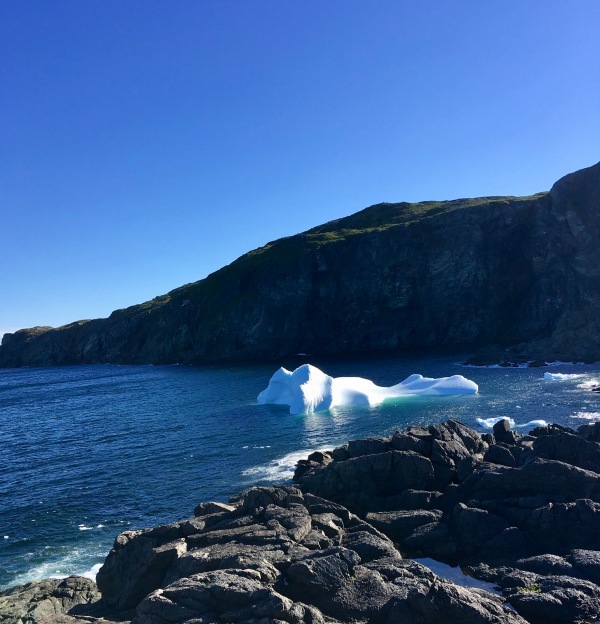
St. Anthony is almost at the top of the Great Northern Peninsula, and first in the line of “Iceberg Alley”, as the icebergs break off each year and make their way south. This year, over 1000 icebergs have been spotted, but the season is winding down – possibly a week or two left to see them.
One of the many fascinating thing about icebergs is how quickly they move and change. We spoke to a woman at our campground who had taken a boat tour out to over 15 icebergs. One week later when we took our tour, we could only access one berg and an ice pan – the rest had drifted south or further out to sea.
This was our view from shore the day before we took our boat tour; half a dozen small icebergs within easy view.

This was our boat, Gaffer III. We were lucky enough to get one of the few seats upstairs.
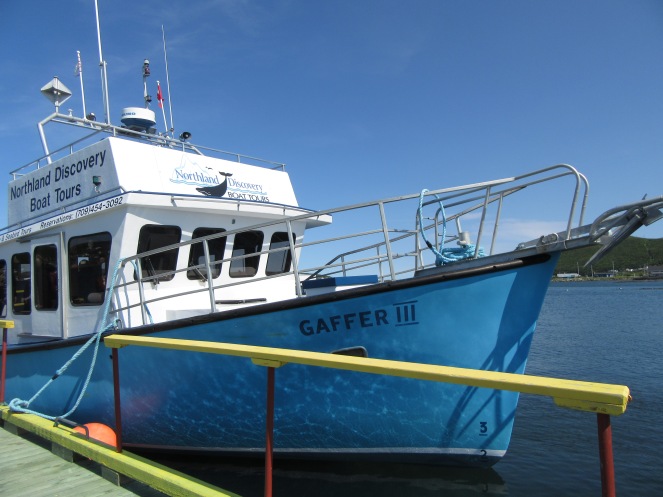
The 2-1/2 hour boat trip was billed as an “iceberg/whale-watching” tour. The challenge with this is that we were on the very tail end of iceberg season and the humpbacks have only begun to come into the area. Our delightful guide tried very hard to make it exciting – he was knowledgable and folksy and charming, but he’s not a magician. We saw the backs of a few minke whales and a pod of dolphins who were feeding and therefore not wanting to play. Right at the end we saw a small humpback, but again – no dramatic breaches or showy tail-flaps. While we would have loved more marine activity, the main draw for us was being able to see an iceberg up close. Our first stop was an ice pan that happened to have a harp seal basking on it.
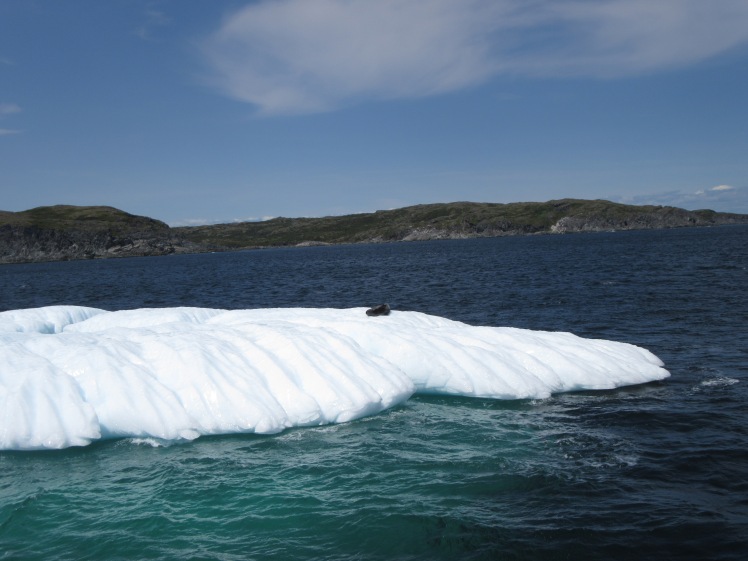
We headed out for about half an hour to the main event – the one large iceberg that was currently still in range. Two other very large icebergs had been part of the tour the day before and 24 hours later they were too far out to access.
Still – this one was awe-inspiring and a little bit scary to be so close. Seventy-five feet high and 265 feet underwater. Translucent white, with greenish tinges and fissures with rivulets of water dripping into the ocean – this iceberg was alive. It had already rolled over a couple of times – indicated by the smooth parts of the iceberg. According to our guide, it was “anchored” – meaning it was stuck in that spot for a while – luckily for us.
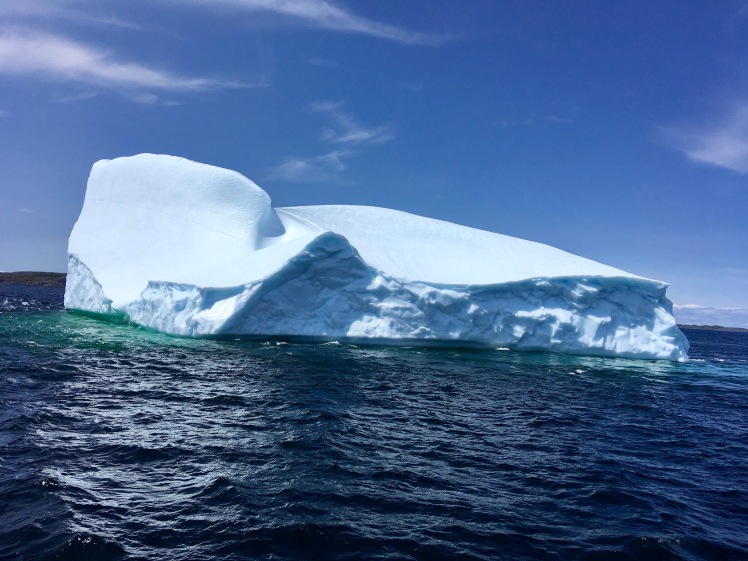
Another view:
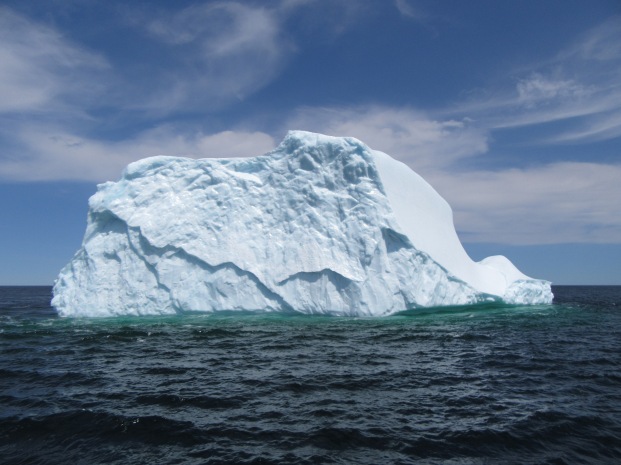
And a nearby piece, probably fractured from this iceberg. Our guide told us the ice pieces around were a good hint that the big iceberg was going to break up. Those ice pieces are also called “bergie bits” – apparently anything smaller than a house or car is not a full-fledged iceberg.
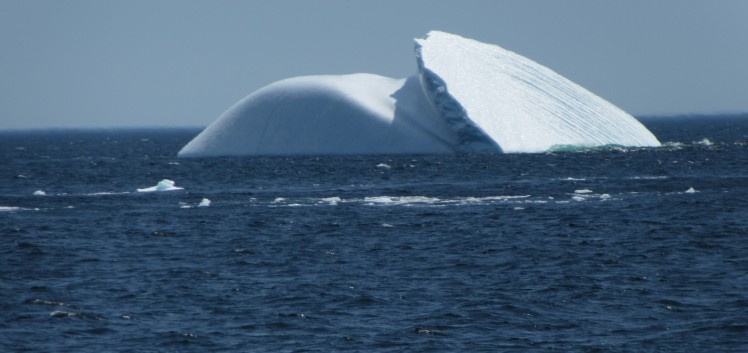
We were treated to iceberg chips – the purest (and oldest – over 10,000 years old) water on the planet. Iceberg water is well marketed – iceberg beer, iceberg vodka, even iceberg doughnuts (for a very brief time during Iceberg Festival) at Tim Hortons. Our guide dropped a net into the water, hauled up a good-sized bergie bit and broke up pieces to sample. Surprisingly, the ice did not taste of salt – it was as pure and clean as the driven snow. Icebergs are so dense they do not easily absorb sea water.
(Please excuse my rough manicure – “camping” fingernails.)
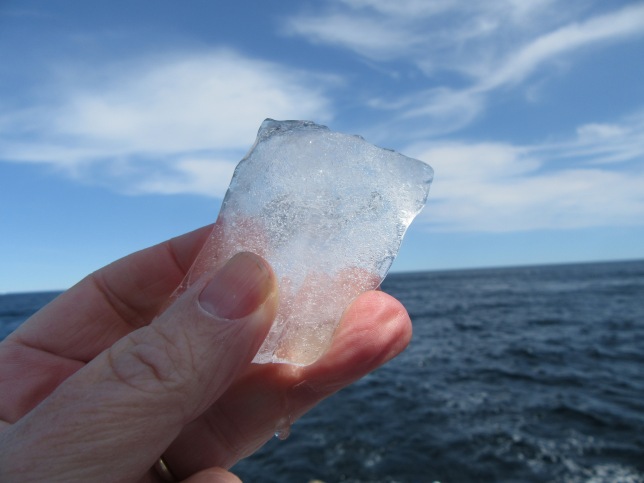
It was an unforgettable experience, but we missed the main event – seeing dozens and dozens of icebergs at their largest and most majestic. Another time, we would plan our visit to Newfoundland for early June.
Of course, the other reason we were way up north was to visit L’Anse aux Meadows. This UNESCO National Historic site (absolutely free this year with our Canada 150 pass!) was the first European settlement in North America, c. AD 1000. It was authenticated in 1960 and is believed to be Leif Ericsson’s Vinland camp. The site begins with an excellent interpretation centre with displays, movies, artifacts and a scale-model of a Viking boat.
Hiking paths wind around the site – one of them along the coast.
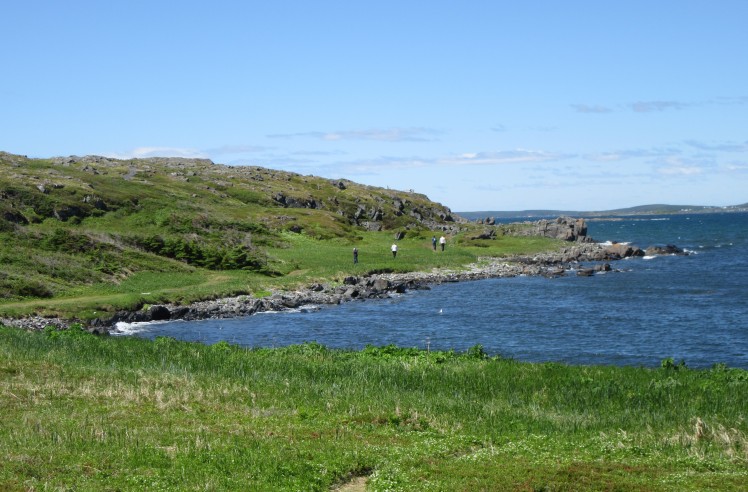
This showpiece sculpture by Luben Boykov is the visitor’s first introduction to the site.
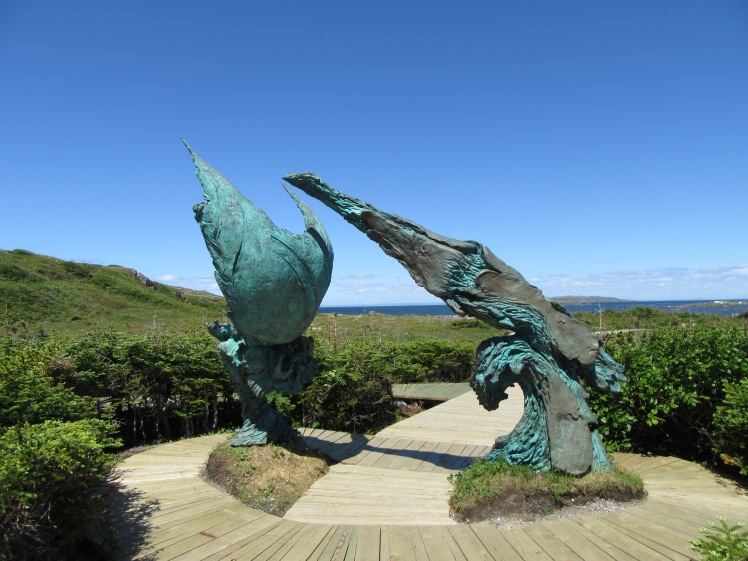
Most of the site are grass-covered mounds, with explanatory plaques – a house, a barn, a foundry etc. They have been excavated, but not recreated.
The main area is comprised of a few reconstructed sod buildings, of peat construction and bolstered by wooden frames. They are not actually built on the original site, but just off to one side.
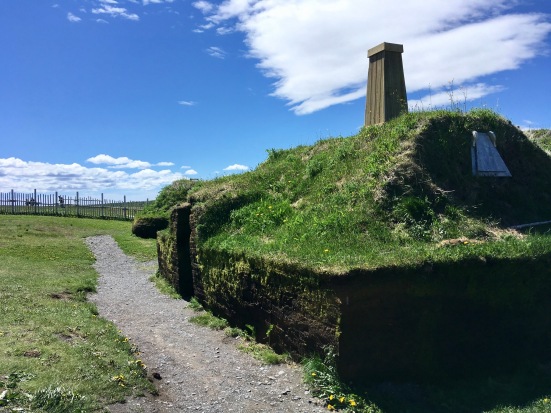
One of the entranceways to the main structure.
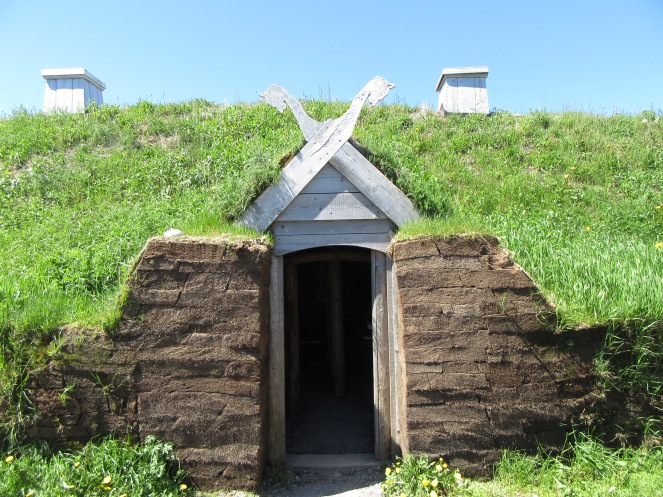
Inside, we found two young women in costume, sitting demurely with needlework in their laps. Suddenly a bearded man appeared, all swashbuckling cape and gruff demeanour. I am most uncomfortable with historical reenactments – I always worry I will be picked out of the crowd and compelled to speak with an accent or indulge in play-acting as a bar wench or scullery maid. Thankfully, there was none of that but we were invited to pick up helmets and swords and try them on. Stephen, who is not at all worried about being centred out, obliged. Not the most fearsome Viking around, but a good sport nonetheless.
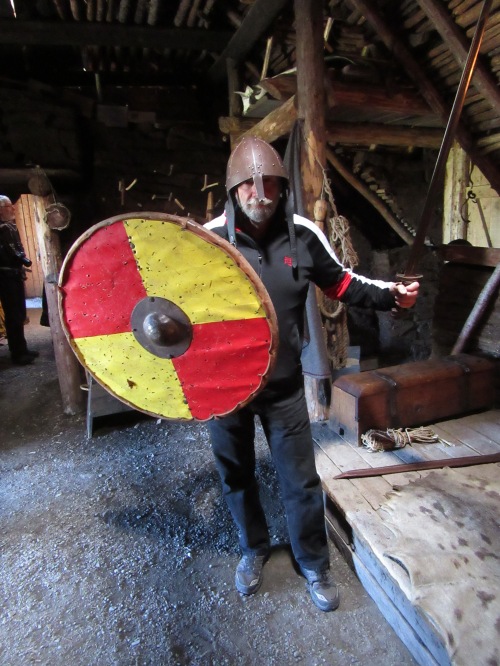
We spent a few hours at L’Anse aux Meadows – the landscape is ancient and barren and it lends itself to imagining historical events from so long ago.
The Northern Peninsula has a dramatically different feel from the mountainous, heavily wooded terrain of Gros Morne. It is all rock and water and wind. A bright day in mid-July still feels like winter is just around the corner. Not a place for the faint of heart, but there is such beauty here.
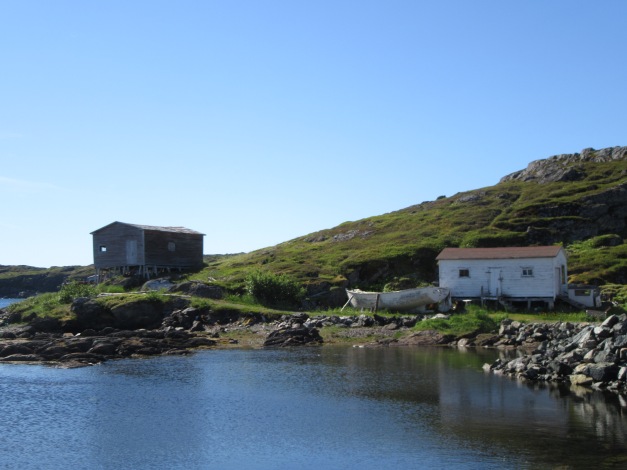
There are two distinctive features in northern Newfoundland that speak to the resident resourcefulness – the roadside garden and the monster woodpile.
We kept seeing gardens either in the ditches beside the roads or just back a bit, but they were all similar – neatly planted rows of vegetables, fenced to keep the moose out. The roadside plantings began years ago when the roads went through and the fill was cast off to the side. Families plant these gardens, amend them each year with seaweed and reap the rewards of a year’s worth of root vegetables.
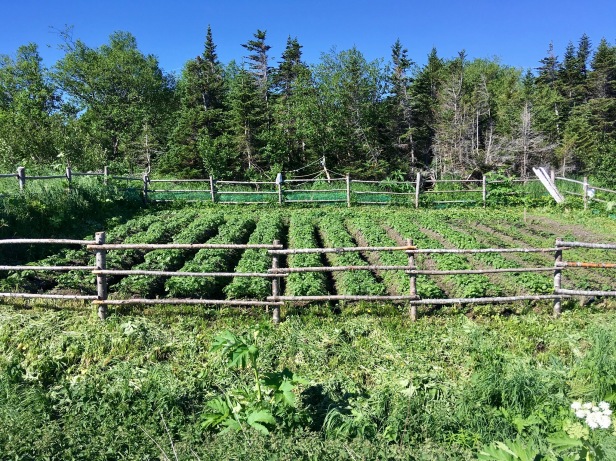
And the woodpiles – unbelievable piles of firewood, right by the side of the road. We became so curious: were these community piles – come and help yourself? Or a business – call and place your order for three cords of wood? We asked the park staffer at our campground about this.
These piles are all cut by individuals or families with a permit and set out by the road to dry. In the fall, the locals haul their wood back to their homes for the winter. We were incredulous – does anyone steal this wood? Apparently not – that would be unneighbourly.

So many interesting differences with both people and place here. We’re in Musgrave Harbour tonight – enroute to St. John’s tomorrow. We’re staying at a motel overlooking the ocean and we just came back from dinner at their restaurant.
At one of the tables was a couple who had worked 25 years in Fort Mac, and 11 years ago left friends and family and grandchildren back in Alberta to “come home.” That is such a common story.
The longer we are in Newfoundland, the more we understand how hard it must be to leave.
So beautiful. Your bloc makes me want to return for another visit.
LikeLike
I don’t think you can ever have enough visits to the Atlantic provinces. You need time to drive down each inlet, take every back road and you would never see it all. I know we’ll be back again at some point. Just one complaint – the potholes on some of the back roads!
LikeLike
I was thrilled to hear you saw some icebergs, even though you missed the main event. Even the one that was pictured in your blog was huge in my eyes! I was also struck by the beauty of this rather harsh landscape. There’s something to be said for simplicity …
LikeLike
There’s a lot to be said for simplicity, isn’t there? That is very evident in Newfoundland – there is great beauty in the starkness.
LikeLike
Beautiful photos and stories…and Stephen as Viking! Thanks for sharing your wonderful journey xo
LikeLike
Thanks Donna – we are having such a wonderful time here – it is like being in a foreign country.
LikeLike